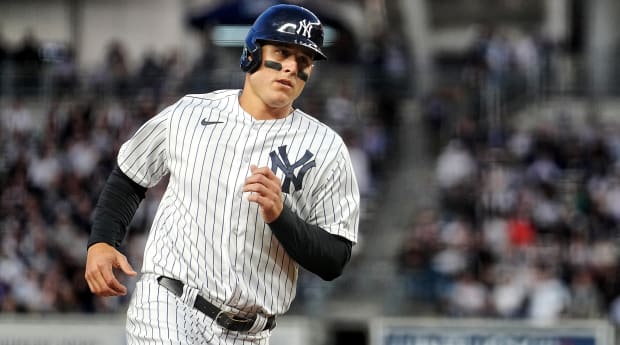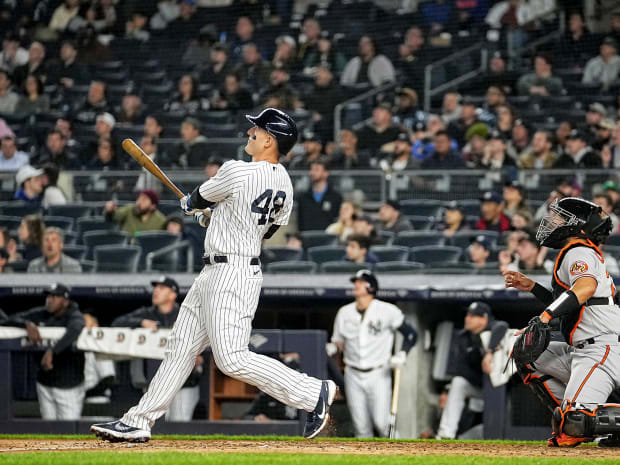
Erick W. Rasco/Sports Illustrated
Welcome to The Opener, where every weekday morning during the regular season you’ll get a fresh, topical story to start your day from one of SI.com’s MLB writers.
NEW YORK — As Anthony Rizzo’s free agency stretched into its fifth month, he realized two things: After a disappointing 2020 and ’21, “the deal that I once envisioned wasn’t gonna be there,” he says. And if he couldn’t get five years, he didn’t want three. He wanted one.
Rizzo has heard the same rumors as everyone else in the sport: Major League Baseball might ban the infield shift after this season. Few hitters would benefit as much as Rizzo, a left-handed slugger who takes nearly four-fifths of his at bats with three infielders clustered to the right of second base, gloves out, waiting for his line drives.
So in March, he signed with the Yankees: a two-year deal, at $16 million each year, with—crucially—an opt-out after 2022.
Rizzo, 32, does not like the term “bet on myself.” He says this setup simply “made sense.” What he does not say is that if he continues to play the way he has—19 games into the season, he leads the league in home runs, with eight, and sits in fourth in OPS, at 1.098—it might not matter what MLB does to the shift.
Still, he would like to see infielders restricted to two per side of second base, as MLB is testing in Class A and Double A this year. “I think every lefty that’s ever played has talked about that,” teammate Joey Gallo says ruefully. In 2018, the Orioles’ Chris Davis told Sports Illustrated that he sometimes looked out of the batter’s box and felt like there were a dozen men out there. “Sometimes more,” Rizzo says, laughing.
Since the shift began to take over the sport that year, only one player has endured that alignment more than Davis (who saw it 89% of the time). Rizzo does not have things much better: Since 2020, opposing teams have employed the shift against him 79% of the time, 11th in baseball among players who have seen more than 2,500 pitches in that span. (Spare a thought for Gallo, the most-shifted player ever, who this year has seen it 93% of the time.)
Rizzo says he does not blame the shift for his struggles in 2020 and ’21, nor does he believe he has beaten it in ’22. “There’s obviously a number of factors,” he says. “They’re not secrets. I just don’t like to share everything. Hitting-wise, all that's gonna come and go. Just the outside factors and all that—it just feels good. Feels good to be here and settled.”

Erick W. Rasco/Sports Illustrated
He spent most of his career settled. After two trades before his rookie eligibility expired, he began to dream of retiring as a Cub, where he was a three-time All-Star and four-time Gold Glover at first base. In 2013, he signed a seven-year, $41 million contract extension with two team options that bought out his first four seasons of free agency. In ’14, he bought an apartment in Chicago. In ’16, he squeezed the final out of the Cubs’ first title since 1908.
But as negotiations on a further extension stalled—Chicago reportedly offered him $60 million for four years, then $70 million for five—and the team began to struggle, Rizzo started imagining life elsewhere. At the deadline last year, president of baseball operations Jed Hoyer began dismantling that championship core, dealing shortstop Javy Báez to the Mets, multiposition star Kris Bryant to the Giants and Rizzo to the Yankees.
“I’m definitely rooting for the Cubs,” Rizzo says slowly. “Getting traded last year, there was a little bit of anger and whatnot. I just think times there were so great, and now it’s about making good times here and just enjoying this.”
He says he loved the Yankees immediately—the teammates, the market size, the chance to win. The native of suburban Parkland, Fla., even liked life in New York City, once he got used to it. (His wife, Emily, especially loves Manhattan, where they live.) “There's no waiting in lines,” he says. “You have to, like, create your own way. If you're waiting, someone will skip you. Just little things like that.”
So when he was deciding among offers, the decision felt obvious. “I knew as soon as I signed it was the right choice,” he says. Manager Aaron Boone says that confidence and comfort is the biggest difference between 2021 Anthony Rizzo, whose OPS+ was 111, and ’22 Anthony Rizzo, whose is 222.
“I think we’re seeing a settled, great player, just kind of entrenched in the middle of everything we do,” Boone says. “He’s such an anchor for us defensively, in the middle of our lineup, from the left-handed side, [as a] voice in our room. He just brings, besides being a great player, so many intangible things he brings to the table on a daily basis that have been really, really impactful.”
Rizzo helps keep things light, teaching outfielder Tim Locastro about NFTs and wearing matching dachshund-themed Hawaiian shirts with right fielder Aaron Judge. After reliever Ron Marinaccio began his major league debut by throwing five straight balls earlier this month, Rizzo called time and made a mound visit. “Trust your stuff,” Rizzo said. “You’re in the big leagues for a reason.” Marinaccio struck the next batter out.
“A guy that’s as accomplished as he is—he's won Gold Gloves, All-Stars, the World Series—but for him to still be so down-to-earth and so accommodating to other veterans, young guys that come up, he's just a special person, that's for sure, and we’re lucky to have him,” says Judge, adding that he staged an aggressive text campaign in the offseason.
It worked. Rizzo says that although he negotiated for a chance at another major payday next year, he is not thinking about that decision. “My mindset is I signed a two-year deal and I plan on being here for two years,” he says. He is comfortable here. Unless something shifts.







